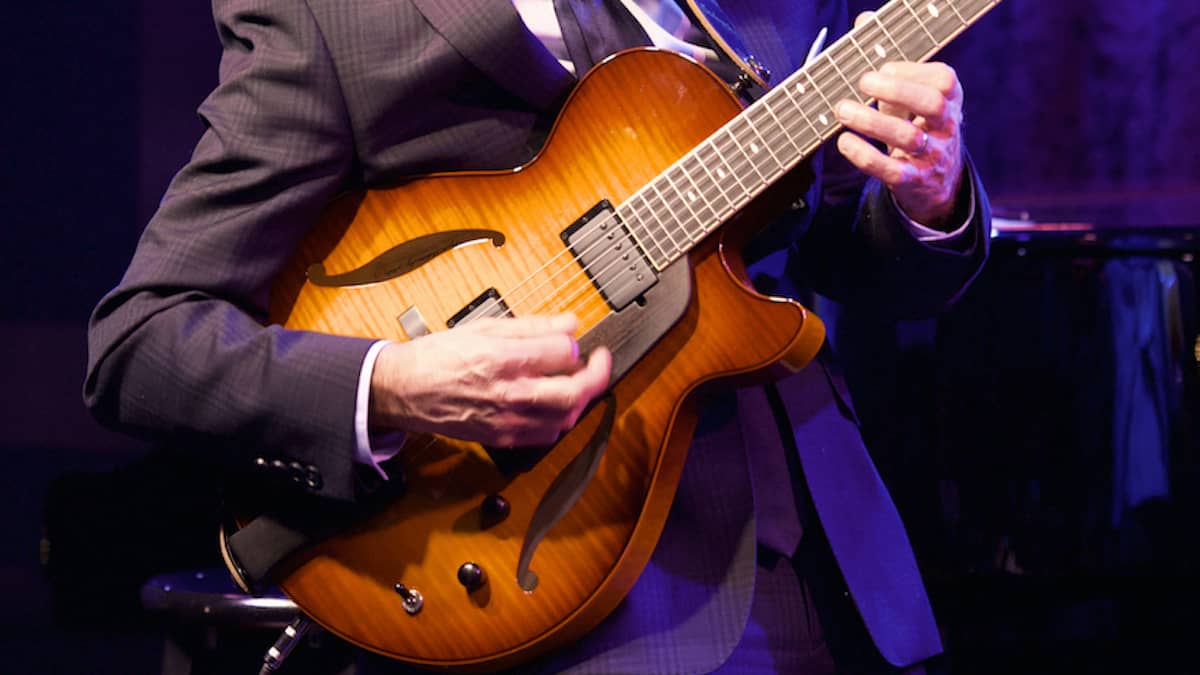Jazz Guitar Lessons
How To Use Tenth Intervals To Enhance Your Solo Guitar Playing, Part 3

In ‘Part Three’ of the lesson, guitarist Ed Acquesta continues to explain how to use tenth intervals to create fluid guitar solos, regardless of style.
Part III – Introduction to 10th’s
Welcome back to Part 3 of our exploration of 10ths for solo guitar! In Lesson I, Parts 1 & 2, we defined 10ths as a compound interval and formed them on the guitar. We then examined 10ths derived from the Drop 2 bottom string set and Drop 2 middle string set chord voicings. Finally, we touched on the multiuse harmonic function of 10th’s and ended with an introductory simple blues etude.
The learning objectives of Part III are:
- Examine major and minor triads, their inversions and the 10th intervals contained within each;
- Explore some possible 10th multiuse harmonic functions;
- Continue to build technique on the bottom and middle string sets.
Let’s begin!
Triads, Inversions & 10ths
Below in Exhibit #1 are F Major triads using the sixth, third and second strings. The first measure contains the triad of root (F), third (A), and fifth (C). Directly below is the corresponding major 10th contained in the triad consisting of the root (F) and the 10th (A).
The same triad and 10th may also function as a rootless D minor seventh (D-7) consisting of the minor third (F), the fifth (A), and the seventh (C). Multiuse 10ths are great for moving efficiently and harmonically on the fretboard. Also, remember that additional notes added to or surrounding the 10th will define its function in your composition. For example, if D was added to the same major 10th (F, A), a rootless BbMaj7 would result. There are other possibilities you will discover on your own. The idea is to use 10ths to build varying harmonies while moving rhythmically on the fretboard.

Measure two in Exhibit #1 is the 1st inversion (3rd in bass) of F Major. The associated 10th is directly below. The F Major triad contains A (3rd), C (5th) and F (root.) The minor 10th interval of A and C are the third (A) and fifth (C) of F Major. This 10th could also function as an A minor comprised of A (root) and C (minor 3rd).
Measure three in Exhibit #1 contains the 2nd inversion of F Major 7th with the 5th (C) in the bass, the major 7th (E) on the third string and the 3rd (A) on the 2nd string. The major 10th located directly below contains a C and E. This 10th may also function as a C Major or an A minor. Add A on the second string to form an A minor triad or a C sixth. Add G on the second string for a C Major triad.
Now let’s turn our attention to the F minor triad in Exhibit #2 below. In the first measure, the triad consists of the root, minor third (Ab) and the fifth (C). This triad could also function as an Ab 6th consisting of the sixth (F), root (Ab) and third (C). Sounding the Sixth on the 6th string is a little clunky but it may be useful in an arrangement.
The corresponding minor 10th directly below includes the root (F) and minor third (Ab). If a Cb (open second string) is added, the 10th could function as a F-7b5 or a Db7th.

The second measure of Exhibit #2 is the 1st inversion of F-7 with Ab (-3rd), C (5th) and Eb (-7th). The major 10th directly below could function as an F minor or an Ab Major.
The third measure in Exhibit #2 is the 2nd inversion of F- and represents a F minor/major. C (5th) is in the bass, E (7th) and Ab (-3rd). The major 10th directly below could function as an F Minor/Major sound or a C Major sound.
Let’s change to the key of Bb and use the middle string set of the fifth and second strings. Below in Exhibit #3 are Bb major triads and their corresponding 10ths. I won’t repeat a detailed explanation again. The process is the same as the F Major examples used above in Exhibits #1 & 2. Play each triad and its corresponding 10th interval on your guitar. Identify multiuse functions by adding different notes to the 10th intervals.
Remember to practice playing the tenths using different fingerings. For the inside string set, alternate between your first and third fingers and your second and fourth fingers. Experiment by adding different notes to the tenths and then identify the sound and/or chord it creates.
Exhibit #4 below includes the Bb minor triads and tenths. Once again alternate fingerings and try adding different notes to the tenths.
Concluding Remarks (Part III)
After a little practice, you will easily recognize tenth shapes on both string sets. Add notes to the 10th’s and identify alternative harmonic possibilities.
Now, practice the 10ths on both string sets and practice the major and minor 10ths through the circle of 5ths. Be sure to mix and match the 10ths on both the bottom and middle string sets.
Next, practice playing the harmonized major scale for every key using only the 10th intervals.
In Part 4, we will start using the 10ths to play simple progressions and then build lines around the 10ths using an etude.
Thanks for reading this lesson and until next time, good luck in all your musical endeavors!
And you can always visit Ed at www.edacquesta.com for more information.
If you missed it, check out Part 1 & Part 2 of the lesson.
Subscribe to Jazz Guitar Today – it’s FREE!
-
Jazz Guitar Lessons2 weeks ago
New JGT Guitar Lesson: Analyzing “Without A Song”
-
Jazz Guitar Lessons4 weeks ago
New JGT Guitar Lesson: Considering “Falling Grace”
-
Artist Features1 week ago
New Kurt Rosenwinkel JGT Video Podcast – July 2024
-
Artist Features2 weeks ago
JGT Talks To Seattle’s Michael Eskenazi





















